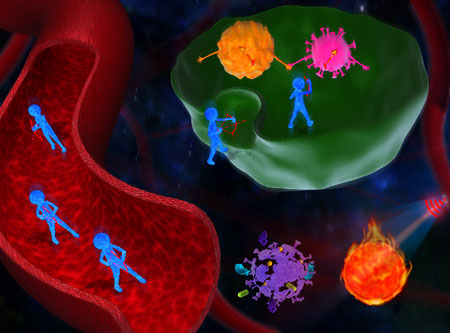| Posted: Jul 23, 2018 | |
Scientists report a new strategy to combine microwave thermal therapy with infection inhibition to effectively treat cancer |
|
| (Nanowerk Spotlight) Researchers in China at Technical Institute of Physics and Chemistry, Chinese Academy of Sciences (CAS) proposed a novel tumor treatment strategy for simultaneous ablating tumor and inhibiting infection. | |
| It is well known that exploring effective anti-tumor treatments is necessary due to the traditional treatments such as surgery, chemotherapy and radiation are not as effective as expected. | |
| In recent years, microwave thermal therapy (MTT) is widely considered to be a potential treatment because of its wide treatment range, high heating efficiency and low side effects. As a promising thermal therapy, MTT has attracted more and more attention. | |
| However, eradication of tumor by MTT is still unable to achieve the cure of tumor in clinic or in practice. The tumor thermal therapy is usually accompanied with infection and inflammatory reactions, which in turn promote tumor growth and metastasis meanwhile. Under such circumstances, taking into account the infection during the cancer eradication is a progressive tumor treatment strategy. | |
| The CAS team was the first to present cases of simultaneous tumor MTT and resistance to bacterial infection. The strategy of simultaneous eradicating tumor tissue and inhibiting infection can inspire the researchers with novel progressing technologies for tumor therapy. | |
 |
|
| A novel strategy can treat tumors by microwave ablation, simultaneously inhibiting bacteria and resisting infections associated with tumor therapy. (Image provided by the CAS researchers) | |
| Metal-organic framework (MOF) is a promising option for this feature because most of the metal ions that make up its periodic reticular structure have antibacterial properties. MOFs are widely used in many applications, including catalytic, gas separation and storage, and drug delivery, due to their large surface area, adjustable pore size, diversified structure, and good biodegradability. | |
| As a subclass of MOFs, zeolitic imidazolate frameworks (ZIFs) has also made great breakthroughs in its research, especially in using ZIFs as carriers. However, there were a few reports about ZIFs for antibacterial applications. | |
| The team designed the new tumor treatment strategy based on biodegradable BSA@ZIF-8 for simultaneous ablating tumor and inhibiting the infection. This biodegradable ZIFs contain abundant porous structure, showing increased absorbing of ions and inelastic collision. | |
| A large amount of friction heat produced by the collision results in increased tumor cell death under microwave irradiation. It can effectively inhibit tumor growth in mice by microwave ablation with a good anti-tumor effect (95.4%). | |
| Intriguingly, the Zn2+ released from the degradation of BSA@ZIF-8 enables the damage of the bacterial cell walls, destruction of the metabolism and structure of membrane, leading to bacterial cell death, and ultimately achieving good antibacterial properties. | |
| Moreover, the BSA@ZIF-8 is biodegradable without long-term toxicity in vivo. The in vivo experiment results show that the BSA@ZIF-8 can protect 80% of the mice from lethal challenge with tumor and accompanied infection. | |
| The results are described in the journal Nanoscale Horizons ("A tumor treatment strategy based on biodegradable BSA@ZIF-8 for simultaneous ablating tumor and inhibiting infection"). | |
| In addition to the MOFs, other materials containing antimicrobial agents and microwave sensitizers can also be used as an alternative to this new strategy. The team also prepared novel trifunctional PEG-IL/ZrO2-Ag@SiO2 NRs which can be used for CT-imaging guided simultaneous tumor MTT and resistance to bacterial infection. | |
| A nanoengineering strategy to successfully synthesized trifunctional PEG-IL/ZrO2-Ag@SiO2 NRs is introduced. | |
| The method for producing silver nanoparticles in the ZrO2@SiO2 nanorattles is a facile and general method. The strategy of simultaneous MTT and inflammation management effectively inhibits tumor growth in mice with a good anti-tumor effect (96.4%). | |
| Importantly, the obtained PEG-IL/ZrO2-Ag@SiO2 NRs also have the ability of CT imaging to allow highly sensitive CT imaging in vivo and in vitro. | |
| The PEG-IL/ZrO2-Ag@SiO2 NRs could be a powerful tool to enhance MTT outcomes for a variety of cancers by simultaneous eradicating tumor tissue and managing inflammation. | |
| The results are described in the journal Biomaterials ("Nanongineering of nanorattles for tumor treatment by CT imaging-guided simultaneous enhanced microwave thermal therapy and managing inflammation"). | |
| Dr. Xianwei Meng who led the research team said: "This novel strategy opens the door for developing the nanomaterials that are sensitive to microwave irradiation and inhibiting infection to achieve noninvasive combined treatment in clinical practice." | |
|
Provided by Technical Institute of Physics and Chemistry, Chinese Academy of Sciences, as a Nanowerk exclusive.
|
|
|
Become a Spotlight guest author! Join our large and growing group of guest contributors. Have you just published a scientific paper or have other exciting developments to share with the nanotechnology community? Here is how to publish on nanowerk.com. |
|
